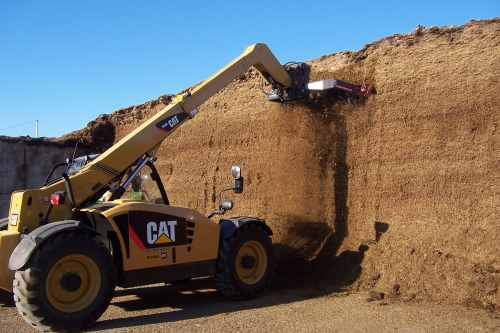Considerations for using a silage facer
A silage facer may provide greater consistency in feed quality and ration composition for producers handling lots of feed daily.
A dairy farm in my area recently purchased a silage facer to take haylage and corn silage out of  bunker silos. Though it is a relatively small investment, this one was around $5000, it seems that this tool is slow to catch on. There are three main areas to consider when thinking through the decision to invest in one.
bunker silos. Though it is a relatively small investment, this one was around $5000, it seems that this tool is slow to catch on. There are three main areas to consider when thinking through the decision to invest in one.
Equipment wear and tear. This was the factor that drove this particular producer to purchase a facer. The wear and tear of using a bucket to dislodge and scrape the well-packed silage from the bunker kept breaking equipment. First his skid steer and then the tele-handler. It was pins and cylinders and then an $8000 repair. The action of using a bucket to remove silage is a series of abrupt actions that stresses equipment. But more than the cost of the repairs, this producer said the downtime of frequently broken equipment was a major factor. Pins for the tele-handler could be replaced for around $30 each but it took several days to get them and if it broke on a weekend, then they were down longer.
Labor consistency. On most farms, the job of getting the feed is delegated primarily to one individual. But on occasions, including days off, times when cropping demands that person or other times, somebody else does it, and frankly, they usually don’t do as good a job on silo face management. Sometimes the employee does it better, sometimes the owner, but the fact is that as multiple people do the job, consistency suffers. A facer reduces the problem of different people doing the job because consistency is easier to achieve.
Face management. We all know that the less exposure that silage has to air, the better preserved it will stay; but, in my travels, I see some pretty ragged silo faces with lots of surface area exposed. It is not just the exposed surface area that deteriorates in quality; it is also the introduction of air back into the pile as a bucket is used to dislodge silage that allows aerobic bacteria to start working behind the face. A facer, with its rotating beater, powered by a hydraulic motor, leaves a face that is still tight and even. Therefore, it reduces the opportunity for feed quality loss.
There are other practical things to understand in regard to using a silage facer. One is that the facer generally takes more time to use than was previously spent with a bucket. In addition, if you are using one piece of equipment for feed, then you have to change from the facer to the bucket to pick up the feed. One has to be prepared to allow more time in these steps. Some of that time is made up in handling the feed that is dislodged. It is looser, with fewer clumps than silage dislodged with a bucket and it requires less mix time. Therefore, it can be added to the mixer and no delay is needed before heading to the barn.
That looseness may also make it easier to add the desired amount to the mixer so that ration consistency may be increased.
With the high price of grains, the value of forages has risen as well. We can’t afford to waste feed or allow it to deteriorate. As with any tool that is used, it should be the goal to harvest, store and feed high quality feed consistently. Some tools help a producer to do that, but it starts with a commitment by the producer and employees to do that, day-in and day-out.
Learn more on this podcast.



 Print
Print Email
Email


